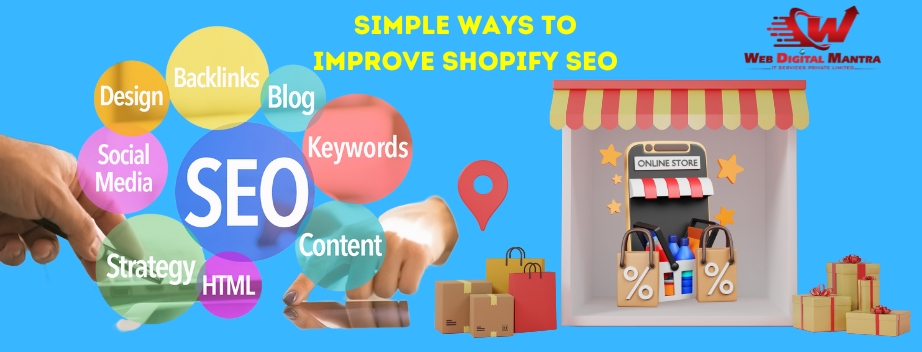
SEO is much needed for an e-commerce website, and Shopify will be no exception. Hence, the optimized Shopify website, therefore, ranks higher in searches, yet drags in more organic traffic, which evidences better visibility and more conversions. If you are a Shopify developer or simply a store owner waiting to maximize your Shopify build website, here is a simple and effective guide to bring your Shopify SEO at a great level.
Shopify is one of the best eCommerce platforms, and the user-friendly features make it the perfect business option. But however great or highly tuned your shop may look, if it does not reach out to the target customers, then it brings zero sales. Here comes the role of Shopify SEO.
Proper structuring makes your site more accessible as well as easier for search engines to quickly crawl through your site.
Tips to Website Structure
Keywords are the most important part of SEO. They help in transcribing your content for a search engine and helping it arrive on the queries of the user
How To Do Successful Keyword Research:
Tools to be used- Google Keyword Planner, SEMrush, Ahrefs for finding appropriate keywords
Long-tail Keywords- Phrases like "best Shopify developer near me" or "affordable Shopify build website services" rank easier.
Analyze Competitors: Find the keywords your competitors are targeting and therefore include them in your strategy.
Where to Place Keywords:
Product titles
Meta descriptions
URLs
Alt tags on images
Blog posts
Your product pages are the lifeline of your Shopify store. They have to be user-friendly yet SEO-friendly.
Product Page SEO Checklist:
Unique Product Titles: Use descriptive titles which include primary keywords
Compelling Descriptions: Write detailed, benefit-focused descriptions loaded with keywords
Optimize all images with compression and descriptive alt texts
Add Reviews. Customer reviews are an excellent way to build trust and improve your SEO.
Meta titles and descriptions are a very important role player in SERP clicks but the next step is to make them workable for SERP clicks.
Best Tips for Meta Titles and Descriptions
Keep It Short and Simple. Title word counts less than 60 characters, and descriptions below 160.
Short and keyword-based URLs are more crucial for SEO.
Optimizing Shopify URLs
Best Practices of Optimizing Shopify URLs
Site speed is a crucial factor in SEO and the overall user experience. Slow sites tend to increase bounce rates and drive down rankings.
How to Improve Site Speed
Content marketing is a very great Shopify SEO tool. It helps you rank for various keywords while giving value to your audience.
Content Ideas for Your Shopify Website
Internal linking links different pages within your website. It aids the search engine's crawl of your site while helping users to quickly find their way around.
Internal Linking Strategies:
Link to blog posts with a product page
Link related products using the "You May Also Like" section
Use descriptive anchor text that includes keywords
Considering that mobile is responsible for most eCommerce traffic, mobile optimization is an absolute requirement.
Mobile SEO Tips
Backlinks are hyperlinks from other sites to yours that tell search engines your site is authoritative and worth their time. Where to Get Backlinks for Your Shopify Site .
Schema markup makes it easier for the search engines to understand your content and as a result make it easy for them to display rich results.
Schema Markup Benefits:
Product ratings and prices will appear in SERPs.
Blog articles to push for higher visibility
Your click-through rates will rise
Check your SEO to know what is working and what not
Tools Used :
If you’re new to SEO or lack the time to implement strategies, Hiring a Shopify developer can be a game-changer.
What to Look for in a Shopify Developer:
Improving your Shopify SEO does not have to be complex. The above simple steps are going to make it possible for you to improve the look of your store, have organic traffic, and upgrade sales performance. Whatever you do-for example, structuring your Shopify website, creating content, or hiring a Shopify developer-each step brings you closer to making your eCommerce store more successful.
Shopify SEO FAQs
1.What is Shopify SEO?
Shopify SEO is the optimization of a Shopify site for better search rankings and additionally to attract organic traffic.
2.How do I improve my Shopify SEO on my website?
Optimize your product pages, relevant keywords, make your websites' speed faster, have high-quality content, and a cell-friendly design.
3.Why is keyword research important in Shopify SEO?
Keywords help search engines to understand your content and match it with user search queries, thereby improving visibility.
4.Do I need a Shopify developer to enhance the SEO?
Not necessarily, but a Shopify developer can also come in handy by implementing advanced strategies and technical improvements from the side of SEO expertise.
5.How long does it take to see results from Shopify SEO?
SEO is always a long-term endeavor. One could start seeing the results of initial improvements within 3-6 months, but consistent effort creates sustainable growth.
 Ganesh B R
Ganesh B R
Copyright @2020. All Rights Reserved by WEB DIGITAL MANTRA IT SERVICES PVT LTD
Post Reviews